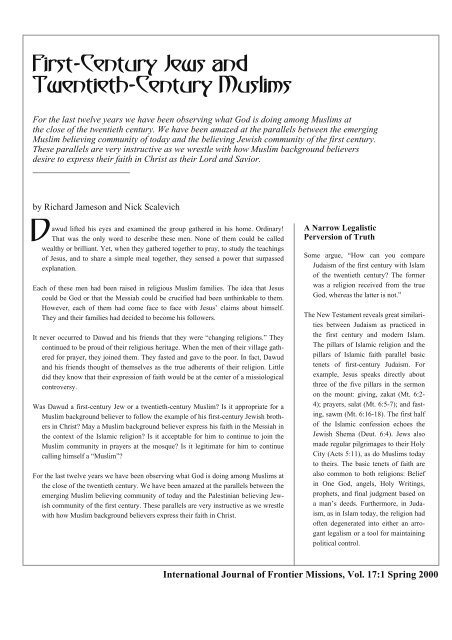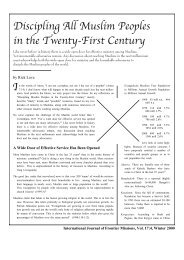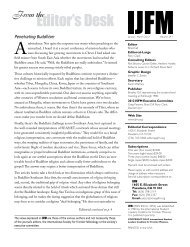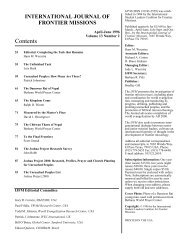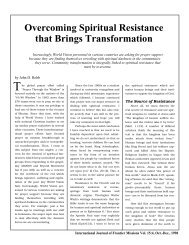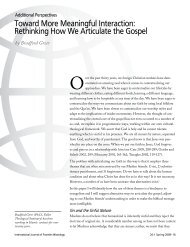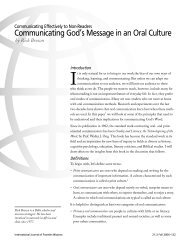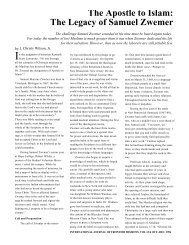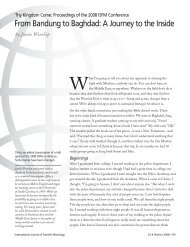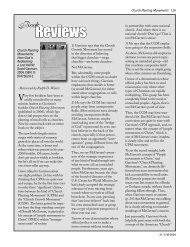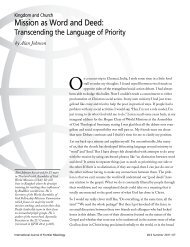First-Century Jews and Twentieth-Century Muslims - International ...
First-Century Jews and Twentieth-Century Muslims - International ...
First-Century Jews and Twentieth-Century Muslims - International ...
Create successful ePaper yourself
Turn your PDF publications into a flip-book with our unique Google optimized e-Paper software.
<strong>First</strong>-<strong>Century</strong> <strong>Jews</strong> <strong>and</strong><strong>Twentieth</strong>-<strong>Century</strong> <strong>Muslims</strong>For the last twelve years we have been observing what God is doing among <strong>Muslims</strong> atthe close of the twentieth century. We have been amazed at the parallels between the emergingMuslim believing community of today <strong>and</strong> the believing Jewish community of the first century.These parallels are very instructive as we wrestle with how Muslim background believersdesire to express their faith in Christ as their Lord <strong>and</strong> Savior.by Richard Jameson <strong>and</strong> Nick ScalevichDawud lifted his eyes <strong>and</strong> examined the group gathered in his home. Ordinary!That was the only word to describe these men. None of them could be calledwealthy or brilliant. Yet, when they gathered together to pray, to study the teachingsof Jesus, <strong>and</strong> to share a simple meal together, they sensed a power that surpassedexplanation.Each of these men had been raised in religious Muslim families. The idea that Jesuscould be God or that the Messiah could be crucified had been unthinkable to them.However, each of them had come face to face with Jesus’ claims about himself.They <strong>and</strong> their families had decided to become his followers.It never occurred to Dawud <strong>and</strong> his friends that they were “changing religions.” Theycontinued to be proud of their religious heritage. When the men of their village gatheredfor prayer, they joined them. They fasted <strong>and</strong> gave to the poor. In fact, Dawud<strong>and</strong> his friends thought of themselves as the true adherents of their religion. Littledid they know that their expression of faith would be at the center of a missiologicalcontroversy.Was Dawud a first-century Jew or a twentieth-century Muslim? Is it appropriate for aMuslim background believer to follow the example of his first-century Jewish brothersin Christ? May a Muslim background believer express his faith in the Messiah inthe context of the Islamic religion? Is it acceptable for him to continue to join theMuslim community in prayers at the mosque? Is it legitimate for him to continuecalling himself a “Muslim”?For the last twelve years we have been observing what God is doing among <strong>Muslims</strong> atthe close of the twentieth century. We have been amazed at the parallels between theemerging Muslim believing community of today <strong>and</strong> the Palestinian believing Jewishcommunity of the first century. These parallels are very instructive as we wrestlewith how Muslim background believers express their faith in Christ.A Narrow LegalisticPerversion of TruthSome argue, “How can you compareJudaism of the first century with Islamof the twentieth century? The formerwas a religion received from the trueGod, whereas the latter is not.”The New Testament reveals great similaritiesbetween Judaism as practiced inthe first century <strong>and</strong> modern Islam.The pillars of Islamic religion <strong>and</strong> thepillars of Islamic faith parallel basictenets of first-century Judaism. Forexample, Jesus speaks directly aboutthree of the five pillars in the sermonon the mount: giving, zakat (Mt. 6:2-4); prayers, salat (Mt. 6:5-7); <strong>and</strong> fasting,sawm (Mt. 6:16-18). The first halfof the Islamic confession echoes theJewish Shema (Deut. 6:4). <strong>Jews</strong> alsomade regular pilgrimages to their HolyCity (Acts 5:11), as do <strong>Muslims</strong> todayto theirs. The basic tenets of faith arealso common to both religions: Beliefin One God, angels, Holy Writings,prophets, <strong>and</strong> final judgment based ona man’s deeds. Furthermore, in Judaism,as in Islam today, the religion hadoften degenerated into either an arrogantlegalism or a tool for maintainingpolitical control.<strong>International</strong> Journal of Frontier Missions, Vol. 17:1 Spring 2000
34<strong>First</strong>-<strong>Century</strong> <strong>Jews</strong> <strong>and</strong> <strong>Twentieth</strong>-<strong>Century</strong> <strong>Muslims</strong>Jesus gave the following commentary onfirst-century <strong>Jews</strong>,You belong to your father, thedevil, <strong>and</strong> you want to carry outyour father’s desire. He was amurderer from the beginning, notholding to the truth, for there is notruth in him. When he lies, hespeaks his native language, for heis a liar <strong>and</strong> the father of lies.—Jn. 8:44 (NIV)This commentary is equally appropriatefor twentieth-century Islam. Yet theEternal Word of God found it necessaryto be made like His brothers in allthings, but without sin (Heb. 2:17;4:15). He entered the world as a lightin the darkness. To the twentiethcenturyMuslim who has become hisfollower, he also says, “As the Fatherhas sent me, in the same manner I sendyou” (Jn. 20:21).As followers of Jesus, Jewish believerscreated a new identity for themselveswithin their old religious identity. ThePalestinian believers clearly perceivedthemselves to be <strong>Jews</strong> both ethnically<strong>and</strong> religiously. Some thirty-five yearsafter Pentecost, James reports that“thous<strong>and</strong>s of <strong>Jews</strong> have believed, <strong>and</strong>Among both Jewishbelievers of the firstcentury <strong>and</strong> Muslimbelievers of thetwentieth, we observe aboldnessto proclaim the gospel,giving full witness tothe person <strong>and</strong> work ofChrist.all of them are zealous for the law” (Acts 21:30). Various sects of Judaism interpretedthe Old Testament Scriptures in a variety of ways. In spite of their heterodoxy,obedience to the Law produced a certain orthopraxy that united all <strong>Jews</strong> in acommon religion. The Jewish followers of Jesus, who zealously kept the law, maintainedtheir right to be called <strong>Jews</strong> both ethnically <strong>and</strong> religiously.As Jewish believers, they adopted for themselves a new self-identity within Judaism.They called themselves, “The Way.” Although Jewish leaders perceived this to bean heretical cult, they did not perceive it to be another religion. Paul’s defensebefore Felix is instructive. He stated,However, I admit that I worship the God of our fathers as a follower ofthe Way, which they call a sect. I believe everything that agrees with theLaw <strong>and</strong> that is written in the Prophets. —Acts 24:14Paul is identifying himself as a Jew to other <strong>Jews</strong>. He will not even concede that he is apart of “a sect,” though he acknowledges Jewish leaders think of Jesus’ followers inthis way. It would be more accurate to say that Paul <strong>and</strong> his Jewish backgroundbelieving friends saw themselves as the only proper expression of Judaism.Similarly, twentieth-century <strong>Muslims</strong> are forging an identity for themselves withinIslam. Over thirty Muslim families, in two strongly Islamic areas, have become “followersof Isa (Jesus).” Some call themselves “followers of the Straight Way.” Theyfeel, live, <strong>and</strong> experience a new power. The power of the gospel has gripped theirlives, making them very different from their Muslim neighbors. They have believedthat Jesus died on the cross for their sins <strong>and</strong> rose from the dead. They now viewJesus as the incarnate eternal Word of Allah who became man. Not only is their theologydifferent, their lives are different. They experience <strong>and</strong> demonstrate a new <strong>and</strong>vibrant love, joy, peace, <strong>and</strong> patience. They have become “new creations.” However,most of them never considered changing their religion. Some of their leaders,who also became followers of the Straight Way, taught them to remain in theirIslamic heritage. After all, the Qur’an teaches that followers of Isa are Muslim(5:111). They are new creations within their old religious environment.New Faith Within Traditional FormsEarly believers continued to worship the Lord as <strong>Jews</strong>. Peter <strong>and</strong> John went “to the templeat the time of prayer—at three in the afternoon”(Acts 3:1). Acts 10:9 showsPeter going to the roof to pray at the time of noon prayers. It appears that the earlybelievers continued to observe the times of prayer as practiced by the Jewish communityat large.They also worshiped in their usual place of prayer, “day by day continuing with onemind in the temple” (Acts 2:46). Peter <strong>and</strong> John also went “to the temple” (Acts3:1). In this very same temple priests were daily offering “up sacrifices first for theirown sins <strong>and</strong> then for the sins of the people” (Heb. 7:27).Jewish believers knew they were saved through the grace of the Lord Jesus, in the sameway as Gentiles were (Acts 15:11). Imagine the confusion their worshiping in thetemple could have caused. Believers who had trusted in Jesus’ one <strong>and</strong> final sacri-<strong>International</strong> Journal of Frontier Missions
35Muslimbelievers, like earlyJewish believers, are forming their owncommunities within Islam, <strong>and</strong> learningto love one another in small home fellowships as believersin Isa.fice for sins were worshiping alongside <strong>Jews</strong> who were still trusting in daily templesacrifices for their atonement. They worshipped God in the same place where theblood of these daily sacrifices was being offered.Could such a practice lead to syncretism? In some cases it must have. Indeed, the bookof Hebrews was written in part to address such syncretistic belief (Heb. 10:1-18).However, twenty-five years after Pentecost, the community of Jewish believers wasstill maintaining their place in the temple. Their leadership actually requested Paul,the great missionary to Gentiles, to make offerings in the temple as a testimony tothe <strong>Jews</strong> of Jerusalem (Acts 21:23-26). It is safe to assume that the benefit of maintaininga testimony to <strong>Jews</strong> from within the Jewish community outweighed the dangerof syncretism in their minds.Mr. Ali, an imam (priest), has become a follower of the Straight Way. His new faith<strong>and</strong> character is now vibrant with the Spirit of Christ. Daily he attends his duties atthe mosque <strong>and</strong> leads those who come to perform salat (ritual prayer). When Mr.Ali preaches, he often quotes from the Injil (New Testament). Many who come tothe mosque are not yet followers of the Straight Way, but at least fourteen familieshave confessed faith in the death <strong>and</strong> resurrection of Jesus, <strong>and</strong> many others are veryinterested in underst<strong>and</strong>ing these new teachings from Mr. Ali. All of these new followersstill worship Allah through salat, but as one of the new believers stated,“Now I truly enjoy my times in salat. These times of prayer <strong>and</strong> worship are nolonger an obligation but a joyful time with my Savior.”All fourteen families continue to participate in Muslim holidays <strong>and</strong> activities. Is therea danger of syncretism? Certainly! But like Jewish believers of the first century,these twentieth-century Muslim believers feel that the opportunity to be lightsamidst the darkness outweighs this risk.One Body, Two CommunitiesIn order for Jewish believers to maintain their position within Judaism, they lived underthe Jewish law <strong>and</strong> apart from Gentiles. James reports that they were “zealous forthe Law.” As such, they had to keep their distance from “unclean” Gentiles. In sodoing, the early Jewish believers were following the example of Jesus. As far as weknow, Jesus never entered a Gentile home. He never violated the Jewish dietarylaws. He lived his life as member of a people who had by <strong>and</strong> large separated themselvesfrom Gentiles.Paul’s writings reveal two distinct categoriesfor the body of Christ: <strong>First</strong> the<strong>Jews</strong>, then the Gentiles (Rom. 1:16;3:29; 9:24). Paul clearly perceived thatthe single Body of Christ was made upof members from both groups whenthey put their faith in Christ (1 Cor.12:13). However, to maintain a crediblewitness to unbelievers from theirrespective communities, many chose tobe one in Spirit yet separate in almostall aspects of everyday life. To reachthose living under the Law, the Jewishbackground believer lived as though hewas under the Law, all the whileknowing Christ had freed him from theLaw (1 Cor. 9:19,20; cf. Fisher 1985).Paul wrote,Nevertheless, each one shouldretain the place in life that theLord assigned to him <strong>and</strong> to whichGod has called him. This is therule I lay down in all the churches.Was a man already circumcised[i.e. a Jew] when he was called?He should not become uncircumcised[i.e. a Gentile]. Was a manuncircumcised [i.e. a Gentile]when he was called? He shouldnot be circumcised [i.e. a Jew].Circumcision is nothing <strong>and</strong> uncircumcisionis nothing. KeepingGod’s comm<strong>and</strong>s is what counts.Each one should remain in the situationwhich he was in when Godcalled him. —1 Cor. 7:17-20[comments mine.]Vol. 17:1 Spring 2000
36<strong>First</strong>-<strong>Century</strong> <strong>Jews</strong> <strong>and</strong> <strong>Twentieth</strong>-<strong>Century</strong> <strong>Muslims</strong>In order for a Palestinian Jew to “retainthe place in life that the Lord assignedto him <strong>and</strong> to which God had calledhim,” he had to separate himself from“unclean” Gentiles, at least to somedegree. Similarly, many twentiethcenturyMuslim believers are finding itnecessary to maintain their distancefrom the traditional Christian communityin order to stay within their Muslimcontext. Christian dietary practices,dress, <strong>and</strong> worship styles make itdifficult for Muslim believers to freelyfellowship with them. To do so woulddestroy their credibility in their owncommunity, as it would have for firstcenturyJewish believers.Ahmed, a leader of a Muslim communityof believers, begged a Christian pastornot to tell other Christians about hismovement: “We are seeing new peoplejoin us on a regular basis. If the [traditional]church finds out about us, theywill want to come see. That willdestroy everything we’ve built. Pleasestay away.”Sharing the GospelAmong both Jewish believers of the first century <strong>and</strong> Muslim believers of the twentieth,we observe a boldness to proclaim the gospel, beginning with the testimony ofthe writings held to be authoritative by the unbelieving community, <strong>and</strong> progressingto a fuller proclamation of the person <strong>and</strong> work of Christ. In Acts 2, Peter preachesChrist’s death <strong>and</strong> resurrection with quotations from the prophet Joel <strong>and</strong> Psalms. InActs 3, he preaches repentance based on Deuteronomy 18 <strong>and</strong> Genesis 22.Paul followed this pattern of ministry to the Gentiles. As long as his audience was primarilyJewish, he relied heavily on the Old Testament Scriptures. However, as soonas he found himself in a context where the Jewish Scriptures were not thought to beauthoritative, he laid his scrolls aside. In Lystra Paul based his message upon God'srevelation of himself in creation, seasons, rainfall, <strong>and</strong> growing crops (Acts 14:14-18). When st<strong>and</strong>ing before the philosophers of the Areopagus, he quotes not fromthe Old Testament but from two poet-philosophers (Bruce, pg 357)In many different villages, Muslim “followers of the Straight Way” often sit <strong>and</strong> sharetheir faith in Christ with friends in the market place, mosque or neighborhood. Mostof these men have never been trained in any methods of outreach, they just sharewhat they have read in the Injil (New Testament) or experienced in their lives sincebelieving in Christ. Mr. Yusuf visits relatives in a strong Muslim area once amonth. Shortly after he placed his faith in Jesus, the Straight Way, he visited relatives<strong>and</strong> began sharing the new power he had through Christ. After many hours ofdiscussion <strong>and</strong> many visits from Mr. Yusuf, four men have also trusted Christ <strong>and</strong>are now studying the Injil. One of these men in turn started his own study groupwith five others.Reinterpretation of the Holy WritingsMuslim backgroundbelievers are formingthe vanguard of a newevangelistic thrust intothe Muslim world. Howwill we respond? Willwe affirm them? Will weencourage them asthey strive to be <strong>and</strong> do towhat God has calledthem to be <strong>and</strong> do?Both Jewish believers of the first century <strong>and</strong> Muslim believers of the twentieth defendtheir faith with their traditional Holy Book. Moreover, both communities radicallyreinterpret these writings based upon their knowledge of God through Jesus Christ.The teachings of the apostles contain hundreds of quotations <strong>and</strong> allusions to theOld Testament. Rarely, if ever, would their interpretations of these passages havemet with the approval of the Jewish religious leadership of their day. Ironically,New Testament writers often used the same hermeneutical methodology, midrash,as did the Jewish leadership of their day (Ellis 1978:151-162), but they arrived atsome very different conclusions. Under the guidance of the Holy Spirit, they foundJesus <strong>and</strong> his church prophesied throughout the Old Testament. Most Jewish rabbisdid not see the same fulfillment of Joel 2 in the events of Pentecost. Similarly, mostscribes did not agree with Peter’s use of Psalm 16 to prove the Messiah had to beraised from the dead. If Jesus or the early disciples ascribed to the practice of onlyallowing the religious elite to determine the meaning of their Holy Scriptures, muchof what we call the New Testament would not have been written.Rashid was responsible for preparing the sermons preached in all the mosques in hisregion. At first he was shocked to hear Rahmat <strong>and</strong> his friends teaching new ideasfrom the Qur’an. Rahmat taught Jesus was the eternal Word of Allah (Qu’ran4:171), born of a virgin, killed <strong>and</strong> raised again. They quoted Surah 19:33 from the<strong>International</strong> Journal of Frontier Missions
Richard Jameson <strong>and</strong> Nick Scalevich37Qur’an, “So Peace is on me the day I was born the day that I die <strong>and</strong> the Day that Ishall be raised up to life (again)”! These “common, uneducated men” now calledthemselves “followers of the Straight Way,” the very “Way” Rashid was obligatedto seek in prayer seventeen times a day! They explained to Rashid that according tothe Qur’an (5:68), they are not of the true religion even a little bit unless they “st<strong>and</strong>fast by the Law, the Gospel, <strong>and</strong> all the revelation that has come to you from yourLord.” They explained that this verse was referring to the Bible. Also, these menboldly declared, “The Injil (New Testament) was not falsified as taught in themosque since ‘. . . In the life of the present <strong>and</strong> in the hereafter: No change can therebe in the words of Allah’ (Qur’an 10:64; 6:115).” Many dozens of verses from theQur’an were interpreted in a new light to Rashid. Looking at the Qur’an through thelens of the Injil was a new experience. These verses prompted Rashid to begin readingthe Injil until he too trusted Christ as his sacrifice.Persecution of Muslim BelieversIt would have been naïve for Jewish believers to assume they could have avoided persecutionby remaining Jewish. Jewish believers faced two types of persecution. Thefirst involved arrests, interrogation, <strong>and</strong> floggings (Acts 4,5). This opposition camebecause Jewish leadership perceived the apostles to be teaching an aberrant form ofJudaism. The apostles were claiming that the crucified Christ had risen from thedead <strong>and</strong> as such had demonstrated that he was the promised Messiah. Jewish leaderswarned <strong>and</strong> flogged the apostles, but then let them go (Acts 5:40). Though persecuted,the Palestinian believing community was able to stay within the Jewish foldprimarily because it continued to worship at the Jewish temple, thereby honoringwhat was sacred to Jewish leadership. The fact that thous<strong>and</strong>s of Jewish believersremained zealous for the law twenty-five years after Pentecost (Acts 21:20) testifiesto their success in maintaining their place within Judaism. When believers began toface this type of persecution, their first <strong>and</strong> foremost prayer request was not thatthey would be protected from harm, but that they would be bold to speak the Word(Acts 4:29).It wasn’t the first time Mr. Alim had come to the house physically beaten for the sakeof his Savior. However, this was the worst beating he had taken. Black <strong>and</strong> blue, thewhole left side of of his face was swollen from the pummeling. Mr. Alim had onceagain paid the price for sharing his faith with a group of Muslim men. It all started afew months earlier, when a few seekers had gathered with him to study about Jesusfrom the Qu’ran. After a few meetings, he began teaching from the Holy Injil (NewTestament). Through the Injil they were coming to underst<strong>and</strong> more fully the personwho they called the Word of Allah. During one of these meetings, suddenly a manburst in to the room, accused Mr. Alim of being the anti-Christ, <strong>and</strong> began to beathim mercilessly. They chased him from the village <strong>and</strong> told him never to return.A few weeks later Mr. Alim came to the house again. His face mostly healed, he excitedlyshared about another group of seekers he had found. Over the next few weekshe shared the gospel with the local witch doctor, a man known for his powerfulblack magic. This man became a follower of Jesus <strong>and</strong> renounced his black power.Seeing the dramatic change in the witch doctor’s life, two village mosque leadersdecided to accept the great sacrificeprovided by Allah. Many continue tocome from surrounding villages tolearn from these three men about Isaal-Masih (Jesus the Messiah), <strong>and</strong> thenumber of believers continues toincrease.In the early church, the second level ofpersecution began with Stephen <strong>and</strong>was characterized by imprisonment<strong>and</strong> martyrdom. F. F. Bruce contendsthat the intense Jewish persecutionagainst the church was focused on theHellenistic believing community, primarilydue to their separation from <strong>and</strong>criticism of the temple (1985:648,649). In contrast to the Hebraic Jewishbelievers, the teachings of HellenisticJewish believers was a cancer to be cutout <strong>and</strong> destroyed. Stephen was stonedto death. Saul organized raids ontowns throughout Palestine, attemptingto eliminate their heresy.In our context, Muslim followers of Jesuswho continue to honor their religioustraditions, the mosque, prayers, fasting,<strong>and</strong> the Muslim holidays are stillcalled to give an account for theirteaching about Jesus. In most casesthey have been able to defend themselvesfrom the Qur’an <strong>and</strong> werereleased to continue their witness inthe community. However, <strong>Muslims</strong>who have left the Islamic fold to“become Christians” face persecutionat a different level. Some have beenVol. 17:1 Spring 2000
38<strong>First</strong>-<strong>Century</strong> <strong>Jews</strong> <strong>and</strong> <strong>Twentieth</strong>-<strong>Century</strong> <strong>Muslims</strong>killed. Most are evicted from theirhomes, divorced by spouses, <strong>and</strong> firedfrom their jobs. Most flee to a largecity, become members of churches <strong>and</strong>marry Christian background spouses.They grow in the Lord but have virtuallyno witness to their own people.Building Each OtherUp in Small Group SettingsAs members of a new community withinan older established community,healthy interpersonal relations quicklyemerge as essential for the life of thegroup. In Acts 2 <strong>and</strong> 4 we see smallgroups gathered for prayer <strong>and</strong> mutualencouragement; they learned fromeach other <strong>and</strong> shared meals together.Within a few years, James, the Lord’sbrother, emerged as the leader of thiscommunity (Acts 12:17; 15:13; 21:18).James begins his letter admonishingJewish readers to receive trials <strong>and</strong>persecutions as the building blocks offaith. He then devotes the bulk of hisepistle to building <strong>and</strong> maintaining acommunity of mutual love <strong>and</strong> compassion.The extraordinary unity ofthese believers was attractive to thecommunity at large (Acts 2:47;5:13b,14).Mr. Nur became a follower of Christ, theStraight Way. He shared the testimonyof the Qur’an concerning the Taurat,Zabur <strong>and</strong> Injil (Bible) with his goodfriend Latif, who had seen a remarkablechange in his life. This, along withthe verses from the Qur’an, convincedLatif to begin studying the Bible. Theyinvited four Muslim friends to jointhem. Almost daily they studied theBible together, <strong>and</strong> soon all six werefollowing Christ. The group grew toalmost forty, then broke into fivegroups that met at different times ofthe week for prayer <strong>and</strong> Bible study.These “cell groups” decided to meet attimes that did not compete withmosque activities. Deep love, concern, <strong>and</strong> mutual support typify each one of thesegroups.Miracles in the Name of IsaBoth Jewish believers of the first century <strong>and</strong> Muslim believers of the twentieth gainedcredibility through miracles. From the linguistic miracle of Pentecost to healings<strong>and</strong> angelic jail breaks, the miraculous placed a hedge of protection around the earlyJewish believers (Acts 3:6-8; 5:12, 17-20). Even the Sanhedrin found it difficult toargue with the miracles that accompanied the faith of early Jewish believers, “Butsince they could see the man who had been healed st<strong>and</strong>ing there with them, therewas nothing they could say” (Acts 4:14).Asgar had long been involved in black magic. He had become crazy over the last fewmonths, possessed by evil spirits. His friends brought him to four Muslim shamansto free Asgar from the spirits, but his condition only worsened. Finally, one Muslimman said in desperation, “Let’s bring him to Mr. Ghafur. He is part of the new sect,the followers of al-Masih (the Christ).” As a last resort, they brought Asgar to Mr.Ghafur, who casts out the demons in the name of Isa al-Masih (Jesus the Messiah).Asgar was miraculously freed. To this day, he is “clothed <strong>and</strong> in his right mind.”Three other demon-possessed men were then brought to Mr. Ghafur, who prayed forthem <strong>and</strong> saw them released from bondage as well. This so impressed the leader ofthe mosque in Mr. Ghafur’s village, he too put his faith in Christ’s sacrifice.ConclusionThe faith of Palestinian Jewish believers described in the book of Acts has given twentieth-centuryMuslim believers a newfound freedom in the way they express theirfaith in Jesus. Like early Jewish believers, they are forming their own communitieswithin Islam, <strong>and</strong> learning to love one another in small home fellowships. They areboldly proclaiming the gospel by beginning with a radical reinterpretation of theQur’an as it bears witness to Christ, <strong>and</strong> then moving to a fuller testimony of theperson <strong>and</strong> work of Christ from the Bible. Although they continue to face persecutionfrom the Muslim majority, they have maintained their witness as religiousinsiders by righteous living accompanied by demonstrations of God’s miraculouspower. These Muslim background believers are forming the vanguard of a newevangelistic thrust into the Muslim world. How will we respond? Will we pray forthem? Will we support them in love? Will we affirm the unique place in life that theBoth Jewish believers of the first century <strong>and</strong> Muslimbelievers of the twentieth gained credibility throughmiracles...The faith of Palestinian Jewish believersdescribed in the book of Acts has giventwentieth-century Muslim believers a newfound freedom inthe way they express their faith in Jesus.<strong>International</strong> Journal of Frontier Missions
Jameson <strong>and</strong> Scalevich39Lord assigned to them in His Kingdom,encouraging them as they striveto remain where God has calledthem? Or will we br<strong>and</strong> them as syncretisticheretics, <strong>and</strong> dem<strong>and</strong> thatthey conform to the ranks of more traditional<strong>and</strong> Western Christianity?ReferencesAd herebyInterServeFisher, John. 1985 “Paul in his JewishContext,” in Evangelical Quarterly.July, pp. 219-223.Ellis, Earle E. 1978 Prophecy <strong>and</strong> Hermeneuticin Early Christianity. Gr<strong>and</strong>Rapids, Michigan: Eerdmans.Bruce, F. F. 1985 “The Church of Jerusalem.”In Bulletin of the John Ryl<strong>and</strong>sUniversity Library of Manchester.Vol. 67, Spring 1985, No. 2.Bruce, F. F. 1954 The Book of Acts.Gr<strong>and</strong> Rapids, Michigan: Eerdmans.Ali, A. Yusuf. 1997 The Meaning of theHoly Qur’an. (9th ed.) Beltsville,Maryl<strong>and</strong>: Amana Publications.Richard Jameson <strong>and</strong>Nick Scalevich have been helpingto develop communities of Muslimbackground followers of Jesus invarious Asian countries over thelast twelve years.MEEMissiological Training by ExtensionGet on-the-job on-going training in missions by email.For info contact IJFM editor:Dr. Hans M. WeerstraEmail: 103121.2610@compuserve.com


